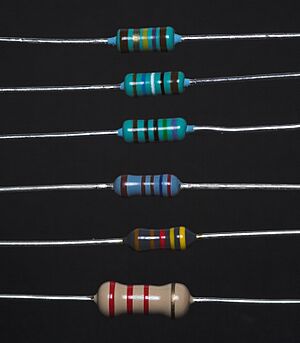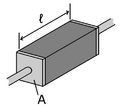Electrical resistance facts for kids
Imagine electricity flowing like water through a pipe. Electrical resistance is how much that pipe makes it hard for the electricity to flow. It shows how voltage (the push of electricity) and current (the amount of electricity flowing) are connected. If there's more resistance, less electricity can get through a circuit. Almost everything has some resistance, except for special materials called superconductors.
Contents
What is Ohm's Law?
A scientist named Georg Simon Ohm discovered resistance in 1827. He found that resistance is basically the relationship between voltage and current. He created Ohm's law, which says that if the temperature stays the same, the voltage between two points in a conductor changes directly with the current.
He described this with a simple math equation:
This equation helps us understand the relationship, where:
 is the resistance of the object. We measure it in ohms (Ω).
is the resistance of the object. We measure it in ohms (Ω). is the voltage across the object. We measure it in volts (V).
is the voltage across the object. We measure it in volts (V). is the current flowing through the object. We measure it in amperes (A).
is the current flowing through the object. We measure it in amperes (A).
How to Calculate Resistance
Think of a road for cars. A long, narrow road makes it harder for many cars to pass. But a short, wide road lets more cars through easily. It's similar with wires and electricity. A long, thin wire has more resistance than a short, thick one.
We can calculate the resistance ( ) of a wire that has the same width all the way through using this formula:
) of a wire that has the same width all the way through using this formula:
In this formula:
 is the length of the wire. We measure it in meters (m).
is the length of the wire. We measure it in meters (m). is the cross-sectional area of the wire. This is like the size of the wire's cut end. We measure it in square meters (m²).
is the cross-sectional area of the wire. This is like the size of the wire's cut end. We measure it in square meters (m²).- Failed to parse (Missing <code>texvc</code> executable. Please see math/README to configure.): ρ (which is the Greek letter rho) is the electrical resistivity of the material. This number tells us how much a specific material naturally resists electricity. We measure it in ohm-meters (Ω m).
Example Calculation
Let's find the resistance of a copper wire.
- The wire has a radius of 2 millimeters (mm).
- Its length is 5 meters (m).
Here's how we solve it:
- The resistivity (
 ) of copper is
) of copper is  Ω m.
Ω m. - First, we find the cross-sectional area (
 ). Since the radius is 2 mm, which is
). Since the radius is 2 mm, which is  meters, the area is
meters, the area is  square meters.
square meters. - The length (
 ) is
) is  meters.
meters.
Now, we use the formula  :
:  So, the resistance of this copper wire is about 0.006685 ohms.
So, the resistance of this copper wire is about 0.006685 ohms.
Where is Resistance Used?
Resistors are special parts used in electrical circuits. Their main job is to provide a specific amount of electrical resistance. This helps control the flow of electricity in a circuit. For example, resistors can make sure that a light bulb gets the right amount of current so it doesn't burn out. They are very important in almost all electronic devices we use every day.
Images for kids
-
A 75 Ω resistor, identified by its electronic color code. An ohmmeter could check this value.
-
When current flows through a material with resistance, it creates heat. This is called Joule heating. Here, a cartridge heater is glowing red hot because of this effect.
See also
 In Spanish: Resistencia eléctrica para niños
In Spanish: Resistencia eléctrica para niños






